Mister Chill |
|
 |
 |
Knitted hat and neck warmer for kids in DROPS Merino Extra Fine. Piece is knitted in stocking stitch with edges in rib and increase for saddle shoulder. Size 2 to 12 years
DROPS Children 41-26 |
|
|
---------------------------------------------------------- EXPLANATION FOR THE PATTERN: ---------------------------------------------------------- DECREASE/INCREASE TIP (evenly): To calculate how to decrease evenly use the total number of stitches decreases are done over (e.g. 100 stitches) and divide by number of decreases to be done (e.g. 4) = 25. In this example decrease by knitting every 24th and 25th stitch together. When increasing make 1 yarn over after every 25th stitch. On next row work yarn overs twisted to avoid holes. DECREASE TIP-1 (applies to top of hat): Decrease as follows at each marker: Slip 1 stitch knitwise, knit 1, pass slipped stitch over stitch worked (= 1 stitch decreased). DECREASE TIP-2 (applies to in the sides front and back on neck warmer): All decreases are done from the right side and decrease inside 5 edge stitches in garter stitch. DECREASE AS FOLLOWS AFTER 5 EDGE STITCHES IN GARTER STITCH: Slip 1 stitch knitwise, knit 1, pass slipped stitch over stitch worked (= 1 stitch decreased). DECREASE AS FOLLOWS BEFORE 5 EDGE STITCH IN GARTER STITCH: Work until 2 stitches remain before the 5 edge stitches, and knit these 2 stitches together (= 1 stitch decreased). INCREASE TIP (applies to saddle shoulder increase): BEFORE MARKER: The new stitch is twisted towards the right. Use left needle to pick up yarn between 2 stitches from round below, pick up yarn from the back and knit stitch in front loop of stitch. AFTER MARKER: The new stitch is twisted towards the left. Use left needle to pick up yarn between 2 stitches from round below, pick up yarn from the front and knit stitch in back loop of stitch. GARTER STITCH (back and forth): Knit all rows. 1 ridge vertically = knit 2 rows. CAST-OFF TIP: To avoid a tight cast-off edge when casting off, you may use a larger needle. If this still is too tight make 1 yarn over after approx. every 4th stitch while casting off (cast off yarn overs as stitches). ---------------------------------------------------------- START THE PIECE HERE: ---------------------------------------------------------- HAT - SHORT OVERVIEW OF THE PIECE: Work piece in the round on a short circular needle/double pointed needles, top down. HAT: Cast on 100-108-112-112 stitches on a short circular needle size 3 mm with DROPS Merino Extra Fine. Knit 1 round. Then work rib in the round (= knit 2/purl 2) for 3 cm. Knit 1 round while decreasing 4-6-4-4 stitches evenly - read DECREASE/INCREASE TIP = 96-102-108-108 stitches. Switch to a short circular needle size 3.5 mm, and work in stocking stitch in the round. REMEMBER THE KNITTING TENSION! When piece measures 13-13-14-15 cm, insert 6 markers in the piece, 16-17-18-18 stitches between each marker. On next round decrease 1 stitch after every marker– read DECREASE TIP-1. Decrease like this on every other round a total of 6-7-7-7 times, and then on every round 6-6-7-7 times in total = 24 stitches remain on needle in all sizes. Knit 1 round where all stitches are knitted together 2 by 2 = 12 stitches remain. Cut the yarn and pull yarn through stitches, tighten together and fasten. Hat measures approx. 19-20-21-22 cm from top and down. ---------------------------------------------------------- NECK WARMER – SHORT SUMMARY OF PIECE: Work piece in the round on double pointed needles/a short circular needle from left shoulder (when garment is worn) - work top down. First work a neck in rib. Then increase stitches for saddle shoulder in each side, before casting off the shoulder stitches. Then finish back piece and front piece back and forth on circular needle separately until finished measurements. NECK: Cast on 96-104-112-120 stitches on a short circular needle size 3 mm with DROPS Merino Extra Fine. Work rib in the round (= knit 2/purl 2) for 8-9-10-11 cm, or desired length. Now insert 4 markers in the piece as explained below - this is done without working the stitches, and each of these 4 markers are inserted between 2 stitches. Use markers when increasing for saddle shoulder. Insert first marker at beginning of round - before first stitch, count 38-38-42-42 stitches (= back piece), insert 2nd marker before next stitch, count 10-14-14-18 stitches (= shoulder), insert 3rd marker before next stitch, count 38-38-42-42 stitches (= front piece), insert 4th marker before next stitch. 10-14-14-18 stitches remain on round for shoulder after last marker. Move these 4 markers upwards when working, increase at each of these markers later. Switch to circular needle size 3.5 mm, and work first round as follows: Work in stocking stitch over the 38-38-42-42 stitches on back piece and decrease at the same time 6 stitches evenly over these stitches – read DECREASE/INCREASE TIP, continue rib over the 10-14-14-18 stitches on shoulder, work in stocking stitch over the 38-38-42-42 stitches on front piece and decrease at the same time 6 stitches evenly over these stitches, continue rib over the 10-14-14-18 stitches on shoulder = 84-92-100-108 stitches. Then increase for saddle shoulder as explained below: SADDLE SHOULDER INCREASE: Continue in stocking stitch over the 32-32-36-36 stitches on back piece and front piece, and rib over the 10-14-14-18 shoulder stitches. REMEMBER THE KNITTING TENSION! AT THE SAME TIME increase 4 stitches on every round for saddle shoulder as follows: Increase BEFORE 2nd and 4th marker and AFTER 1st and 3rd marker - read INCREASE TIP (= 4 stitches increased - the increased stitches are part of front and back piece, i.e. the 10-14-14-18 shoulder stitches stays the same). Increase this way this EVERY round 8-10-12-12 times in total = 116-132-148-156 stitches. On next round cast off shoulder stitches, i.e. work as follows from beginning of round (= at 1st marker): Purl 5, 38-42-50-50 stitches in stocking stitch, purl 5, cast off the 10-14-14-18 shoulder stitch with purl over purl and knit over knit (make sure to avoid a tight cast-off edge), purl 5, 38-42-50-50 stitches in stocking stitch, purl 5, cast off the 10-14-14-18 shoulder stitches with purl over purl and knit over knit. Do not cut the yarn. Then work back and front piece separately back and forth on circular needle. BACK PIECE: = 48-52-60-60 stitches. Work first row as follows from right side: 5 edge stitches in GARTER STITCH - read explanation above, work in stocking stitch until 5 stitches remain on row, and finish with 5 edge stitches in garter stitch. Continue back and forth in stocking stitch with 5 edge stitches in garter stitch in each side. AT THE SAME TIME when piece measures 2-3-3-3 cm from where the shoulder was cast off, decrease 1 stitch in each side - read DECREASE TIP-2. Decrease like this every 2½-3-3-3 cm 3-3-4-4 times in total in each side = 42-46-52-52 stitches. Work until piece measures 10-12-13-14 cm from where the shoulder stitches were cast off. Approx. 3 cm remain until finished measurements, try the neck warmer on for desired length Now increase stitches as explained below to stop the rib from contracting. Purl 1 row from wrong side while increasing 10-10-12-12 stitches evenly - remember DECREASE/INCREASE TIP = 52-56-64-64 stitches. Switch to circular needle size 3 mm. Work next row as follows from right side: 5 edge stitches in garter stitch, * knit 2, purl 2 *, repeat from *-* until 7 stitches remain on needle, knit 2, and finish with 5 edge stitches in garter stitch. Continue rib like this for 3 cm. Cast off stitches with knit over knit and purl over purl - read CAST-OFF TIP! Neck warmer measures approx. 13-15-16-17 cm from where the shoulder stitches were cast off. FRONT PIECE: = 48-52-60-60 stitches. Work the same way as on back piece i.e. front and back piece are identical. |
|
|
Have you made this or any other of our designs? Tag your pictures in social media with #dropsdesign so we can see them! Do you need help with this pattern?You'll find tutorial videos, a Comments/Questions area and more by visiting the pattern on garnstudio.com. © 1982-2024 DROPS Design A/S. We reserve all rights. This document, including all its sub-sections, has copyrights. Read more about what you can do with our patterns at the bottom of each pattern on our site. |
|










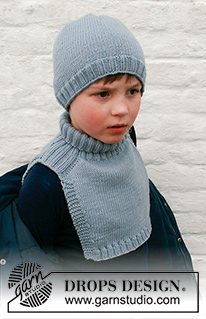
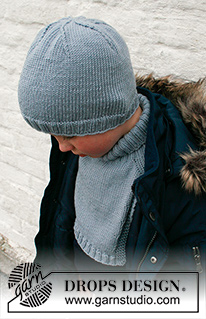






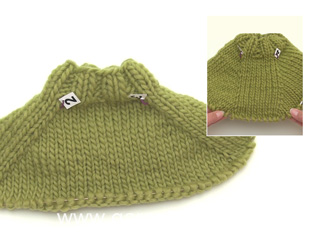




































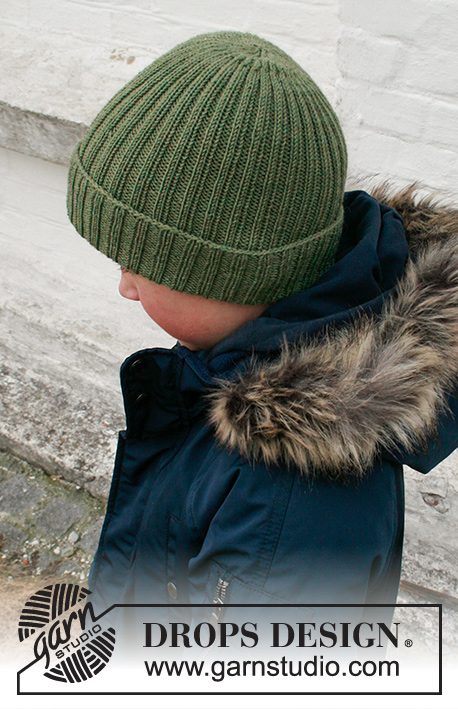

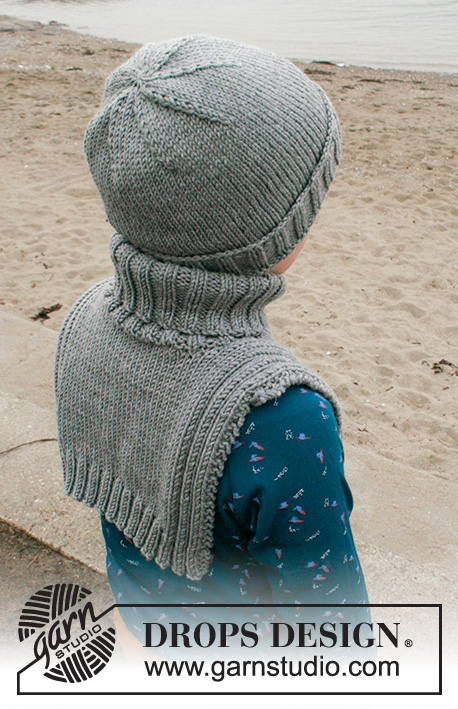






Comments / Questions (8)
Hello, I wanna make a suggestion for improving the translation for the hat. in the sentence with the decreasing, it.s not translated correctly, it.s written "Decrease like this on every other round a total of 6-7-7-7 times, and then on every round 6-6-7-7 times in total = 24 stitches remain on needle in all sizes."which has no sense. I looked for the norvegian version and it.s like this: dec on every 2nd round 6-7-7-7 times, and then on every round... :)
12.03.2023 - 15:28Vielen Dank für die schnelle Rückmeldung, wünsche Ihnen dem ganzen Team eine gute Zeit und bleiben Sie Gesund ❤️
16.12.2022 - 10:56Es geht um die Kindermütze vonDROPS Children 41-26. Nach dem Bündchen kommt die Reihe mit 4 Maschen verteilt abnehmen. Dann 15 cm glatt stricken. Meine Frage wäre mit oder ohne Bündchen. Um baldige Antwort wäre ich Ihnen sehr dankbar. Mit freundlichen Grüßen Becker Margot
15.12.2022 - 16:48DROPS Design answered:
Liebe Frau Becker, bei der Mütze strickt mann glatt rechts bis die Mütze insgesamt 15 cm von der Anschlagskante misst, dh 12 cm nach dem Bündchen (letzte Größe). Viel Spaß beim stricken!
16.12.2022 - 08:16Hei, malli on kiva, ja todella helppo toteuttaa! Tuli oikein mukava myssy ja kauluri :) Kiitos ohjeesta!
13.12.2022 - 08:22Hej!! Står det inte fel i beskrivningen när man ska öka på sadelmaskorna? \r\n\r\nI videon så stickar hon FÖRE 1 och 3 markören \r\nOch EFTER på 2 och 4 markören.
06.10.2022 - 13:16Vielen Dank für die schnelle Antwort und den Link. \r\nDass Sie das Buch nicht kennen, habe ich nicht erwartet und macht ja auch nichts. Meine Frage ist: \r\nVerhält sich die DROPS MERINO EXTRA FINE so, dass sich eine Mütze mit ca. 40-44 cm Durchmesser auf Erwachsenenkopfgröße = ca. 55/56 cm dehnt? \r\nVielleicht möchten Sie mir noch mal schreiben? Herzlichen Dank!
13.09.2022 - 11:39Hallo, ich hätte eine Frage und würde mich SEHR über Antwort freuen, es geht - wie bei der Mütze hier - um Drops Merino Extra Fine: Ich habe das Buch "Klompelompe", da sind ganz viele Anleitungen mit diesem Garn drin, z.B.: Erwachsenen Mütze, Anschlag 88 M, das ergibt ausgehend von der Maschenprobe (und ausprobiert!) viel zu wenig Kopfumfang, nämlich 40 cm. Bei den div. Kindermützen ist es genauso. Ist das wirklich ok, dehnt es sich 15 cm?? Oder wie viel M anschlagen? VIELEN DANK!
12.09.2022 - 18:25DROPS Design answered:
Liebe Monika, wir kennen dieses Buch leider nicht aber hier finden Sie einige Korrektur von ihrer Website, vielleicht kann das Ihnen helfen. Viel Spaß beim stricken!
13.09.2022 - 10:23Hi working on the hat: "On next round decrease 1 stitch after every marker– read DECREASE TIP-1. Decrease like this on every other round a total of 6-7-7-7 times, and then on every round 6-6-7-7 times in total = 24 stitches remain on needle in all sizes." How many St are decreased per round? Thanks.
01.11.2021 - 00:30DROPS Design answered:
Dear Selam, if you are writing about the hat, you should have put 6 marker in the hat previously, and since the instructions say you should decrease after EACH marker, that means, you should decrease 6 stitches in every round with decreasing. Happy Stitching!
01.11.2021 - 11:41